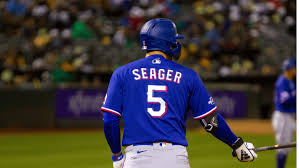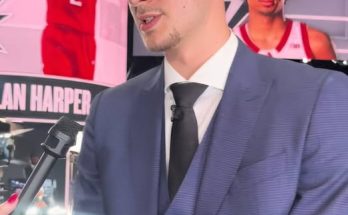The Texas Rangers have been riding high with an impressive start to the season, but they’ve faced a recent challenge in the form of a lingering injury to star shortstop Corey Seager. The 29-year-old, who has been a key contributor to the Rangers’ success, has been sidelined due to a hamstring strain, an injury that has affected his ability to stay on the field and maintain the level of play that fans have come to expect from him.
Seager’s hamstring injury initially forced him to sit out for two games in early May, a blow to the Rangers’ lineup as they looked to build momentum for the stretch ahead. With his potent bat and leadership abilities, Seager has been a cornerstone for Texas, and his absence was keenly felt. While the Rangers were able to manage during his short stint on the bench, it was clear that his return would be pivotal to their success in the weeks to come.
Seager’s comeback on May 10 gave fans a glimpse of why he is so integral to the Rangers’ offense. In his first game back, Seager put on a show, hitting two home runs and a double, driving in key runs for the team. His ability to swing the bat so effectively after missing just a few games was a testament to his skill and determination. Fans rejoiced as Seager’s powerful performance seemed to signal that he was ready to return to full form and help the Rangers continue their strong season.
However, manager Bruce Bochy was quick to temper expectations, revealing that Seager was still not fully recovered from the hamstring strain. According to Bochy, Seager was only playing at about 85 percent capacity, a concerning statement for a player who had just delivered such an electric performance. Despite the two-homer game, it was clear that Seager was not yet back to his full self, which made his injury status all the more complicated.
Seager’s hamstring injury had been lingering, and the fact that it “flared up” again after his impressive return only highlighted the challenges that the Rangers were facing. On May 11, Seager was absent from the lineup for the finale of the series, a decision that left fans both disappointed and concerned about the severity of the injury. The flare-up seemed to indicate that Seager’s recovery process was not going as smoothly as hoped, and the team would have to be cautious with how they managed his return to the field moving forward.
In response to the injury, Bochy announced that Seager would undergo further evaluations on May 12. This decision to reassess the injury was a critical one, as the Rangers needed to get a clearer picture of Seager’s condition and determine the best course of action. Given that hamstring injuries can be tricky to navigate, especially for a player who relies heavily on his speed and agility, there was no rush to put Seager back in the lineup before he was fully ready. The Rangers were in the midst of an important stretch of games, but the team needed to prioritize Seager’s long-term health over any short-term gains.
The idea of managing Seager’s injury while also keeping him engaged with the team is a delicate balancing act for Bochy and the Rangers’ coaching staff. On one hand, Seager’s presence in the lineup is undeniable, and his ability to impact games is crucial for a team that is looking to compete in a highly competitive AL West division. On the other hand, pushing Seager too hard too soon could risk further aggravating the injury, something the Rangers cannot afford if they hope to make a deep playoff push later in the season.
As the Rangers continue to navigate this situation, one thing is clear: Corey Seager’s importance to the team cannot be overstated. When healthy, Seager is one of the most dangerous hitters in the game, capable of changing the course of a game with a single swing. His defensive prowess at shortstop also provides stability to the Rangers’ infield, and his leadership in the clubhouse is invaluable. The team has shown it can be competitive without Seager in the lineup, but it is clear that they are at their best when he is on the field.
For Seager, the road to full recovery will require patience and diligence. He has been through his fair share of injuries over the years, and this hamstring strain will likely be another hurdle in what has already been a career full of ups and downs. However, Seager has always shown resilience, and his ability to bounce back from setbacks has been a hallmark of his career. With the Rangers’ medical staff working diligently to monitor his condition, it is hoped that Seager can find the right balance between rest and rehabilitation to avoid further setbacks.
The next steps for Seager will depend largely on the results of his upcoming evaluations. If the results are promising, there is a chance that Seager could return to action sooner rather than later. However, if the injury is more serious than initially believed, the Rangers may need to take a more conservative approach and keep Seager sidelined for a longer period of time. Either way, the team will need to adjust its expectations and approach to the remainder of the season based on Seager’s health and availability.
One thing that cannot be ignored in this situation is the depth of talent on the Rangers’ roster. While Seager is undoubtedly a key player, the team has a number of other talented individuals who have stepped up in his absence. From the pitching staff to the supporting players in the lineup, the Rangers have shown that they are capable of competing at a high level even when their star shortstop is not in the game. This depth will be critical as the Rangers continue their pursuit of a postseason berth, and it will allow the team to weather the storm if Seager’s injury lingers longer than expected.
In the short term, the Rangers will likely continue to rely on players like Marcus Semien, Nathaniel Lowe, and Adolis García to carry the offensive load. These players have all had strong seasons and have the ability to step up in big moments. On the mound, the Rangers’ pitching staff, led by ace Jon Gray, has been one of the team’s biggest strengths, and they will need to keep performing at a high level to ensure that the team stays competitive.
The longer-term hope, of course, is that Seager will return to full health and rejoin the Rangers at his best. A healthy Seager gives the team a legitimate chance to make a run at the playoffs and, perhaps, even the World Series. His combination of offensive firepower and defensive stability makes him one of the most complete players in the game, and the Rangers are at their most dangerous when he is in the lineup.
As the Rangers wait for the results of Seager’s evaluations, they will continue to focus on maintaining their momentum. The team has a strong core of players and a clear vision for success, but the path forward will likely depend on the health and availability of Seager. If the injury is behind him, the Rangers will be able to push forward with confidence. If not, they will have to make adjustments and continue to perform at a high level without their star shortstop.
For Seager, the key to returning to full health is taking the necessary time and steps to ensure that his hamstring is properly healed. With the right approach and the support of his teammates and coaching staff, Seager can overcome this injury and continue to be the force that drives the Rangers toward success. As always, Rangers fans are hopeful that this injury will be a minor setback, and that Seager will soon be back to doing what he does best: leading his team to victory.



